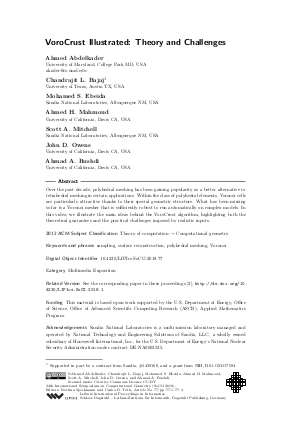VoroCrust Illustrated: Theory and Challenges (Multimedia Exposition)
Authors Ahmed Abdelkader, Chandrajit L. Bajaj, Mohamed S. Ebeida, Ahmed H. Mahmoud, Scott A. Mitchell, John D. Owens, Ahmad A. Rushdi
-
Part of:
Volume:
34th International Symposium on Computational Geometry (SoCG 2018)
Part of: Series: Leibniz International Proceedings in Informatics (LIPIcs)
Part of: Conference: Symposium on Computational Geometry (SoCG) - License:
 Creative Commons Attribution 3.0 Unported license
Creative Commons Attribution 3.0 Unported license
- Publication Date: 2018-06-08
File

PDF
LIPIcs.SoCG.2018.77.pdf
- Filesize: 431 kB
- 4 pages
Document Identifiers
Subject Classification
Keywords
- sampling
- surface reconstruction
- polyhedral meshing
- Voronoi
Metrics
- Access Statistics
-
Total Accesses (updated on a weekly basis)
0Document
0Metadata
Abstract
Over the past decade, polyhedral meshing has been gaining popularity as a better alternative to tetrahedral meshing in certain applications. Within the class of polyhedral elements, Voronoi cells are particularly attractive thanks to their special geometric structure. What has been missing so far is a Voronoi mesher that is sufficiently robust to run automatically on complex models. In this video, we illustrate the main ideas behind the VoroCrust algorithm, highlighting both the theoretical guarantees and the practical challenges imposed by realistic inputs.
Cite As Get BibTex
Ahmed Abdelkader, Chandrajit L. Bajaj, Mohamed S. Ebeida, Ahmed H. Mahmoud, Scott A. Mitchell, John D. Owens, and Ahmad A. Rushdi. VoroCrust Illustrated: Theory and Challenges (Multimedia Exposition). In 34th International Symposium on Computational Geometry (SoCG 2018). Leibniz International Proceedings in Informatics (LIPIcs), Volume 99, pp. 77:1-77:4, Schloss Dagstuhl – Leibniz-Zentrum für Informatik (2018)
https://doi.org/10.4230/LIPIcs.SoCG.2018.77
BibTex
@InProceedings{abdelkader_et_al:LIPIcs.SoCG.2018.77,
author = {Abdelkader, Ahmed and Bajaj, Chandrajit L. and Ebeida, Mohamed S. and Mahmoud, Ahmed H. and Mitchell, Scott A. and Owens, John D. and Rushdi, Ahmad A.},
title = {{VoroCrust Illustrated: Theory and Challenges}},
booktitle = {34th International Symposium on Computational Geometry (SoCG 2018)},
pages = {77:1--77:4},
series = {Leibniz International Proceedings in Informatics (LIPIcs)},
ISBN = {978-3-95977-066-8},
ISSN = {1868-8969},
year = {2018},
volume = {99},
editor = {Speckmann, Bettina and T\'{o}th, Csaba D.},
publisher = {Schloss Dagstuhl -- Leibniz-Zentrum f{\"u}r Informatik},
address = {Dagstuhl, Germany},
URL = {https://drops.dagstuhl.de/entities/document/10.4230/LIPIcs.SoCG.2018.77},
URN = {urn:nbn:de:0030-drops-87903},
doi = {10.4230/LIPIcs.SoCG.2018.77},
annote = {Keywords: sampling, surface reconstruction, polyhedral meshing, Voronoi}
}
Author Details
References
- A. Abdelkader, C. Bajaj, M. Ebeida, A. Mahmoud, S. Mitchell, J. Owens, and A. Rushdi. VoroCrust illustrated: theory and challenges (video content). URL: http://computational-geometry.org/SoCG-videos/socg18video/videos/VoroCrust/.
- A. Abdelkader, C. Bajaj, M. Ebeida, A. Mahmoud, S. Mitchell, J. Owens, and A. Rushdi. Sampling conditions for conforming Voronoi meshing by the VoroCrust algorithm. In 34th International Symposium on Computational Geometry (SoCG 2018), pages 1:1-1:16, 2018. URL: http://dx.doi.org/10.4230/LIPIcs.SoCG.2018.1.
-
A. Abdelkader, C. Bajaj, M. Ebeida, A. Mahmoud, S. Mitchell, J. Owens, and A. Rushdi. VoroCrust: Voronoi meshing without clipping. Manuscript, In preparation.

-
A. Abdelkader, C. Bajaj, M. Ebeida, and S. Mitchell. A Seed Placement Strategy for Conforming Voronoi Meshing. In Canadian Conference on Computational Geometry, 2017.

-
J. Ahrens, B. Geveci, and C. Law. Paraview: An end-user tool for large-data visualization. In C. Hansen and C. Johnson, editors, Visualization Handbook, pages 717-731. Butterworth-Heinemann, 2005.

-
N. Amenta and R.-K. Kolluri. The medial axis of a union of balls. Computational Geometry, 20(1):25-37, 2001. Selected papers from the 12th Annual Canadian Conference.

-
N. Bellomo, F. Brezzi, and G. Manzini. Recent techniques for PDE discretizations on polyhedral meshes. Mathematical Models and Methods in Applied Sciences, 24(08):1453-1455, 2014.

-
T. Brochu, C. Batty, and R. Bridson. Matching fluid simulation elements to surface geometry and topology. ACM Trans. Graph., 29(4):47:1-47:9, 2010.

-
F. Chazal and D. Cohen-Steiner. A condition for isotopic approximation. Graphical Models, 67(5):390-404, 2005. Solid Modeling and Applications.

-
F. Chazal and A. Lieutier. Smooth manifold reconstruction from noisy and non-uniform approximation with guarantees. Computational Geometry, 40(2):156-170, 2008.

-
S.-W. Cheng, T. Dey, and J. Shewchuk. Delaunay Mesh Generation. CRC Press, 2012.

- Microsoft Corporation. Bing Speech API. URL: https://azure.microsoft.com/en-us/services/cognitive-services/speech/.
-
M. Ebeida and S. Mitchell. Uniform random Voronoi meshes. In International Meshing Roundtable (IMR), pages 258-275, 2011.

-
R. Eymard, T. Gallouët, and R. Herbin. Finite volume methods. In Techniques of Scientific Computing (Part 3), volume 7 of Handbook of Numerical Analysis, pages 713-1018. Elsevier, 2000.

-
R.-V. Garimella, J. Kim, and M. Berndt. Polyhedral mesh generation and optimization for non-manifold domains. In International Meshing Roundtable (IMR), pages 313-330. Springer International Publishing, 2014.

- OpenShot Studios, LLC. OpenShot Video Editor. URL: http://www.openshot.org/.
- M. Peric and S. Ferguson. The advantage of polyhedral meshes. Dynamics - Issue 24, page 4–5, Spring 2005. The customer magazine of the CD-adapco Group, currently maintained by Siemens at http://siemens.com/mdx. The issue is available at http://mdx2.plm.automation.siemens.com/magazine/dynamics-24 (accessed March 29, 2018).
-
C. Reas and B. Fry. Processing: A Programming Handbook for Visual Designers and Artists. The MIT Press, 2014.

-
M. Sents and C. Gable. Coupling LaGrit Unstructured Mesh Generation and Model Setup with TOUGH2 Flow and Transport. Comput. Geosci., 108(C):42-49, 2017.

-
M. Yip, J. Mohle, and J. Bolander. Automated modeling of three‐dimensional structural components using irregular lattices. Computer-Aided Civil and Infrastructure Engineering, 20(6):393-407, 2005.

